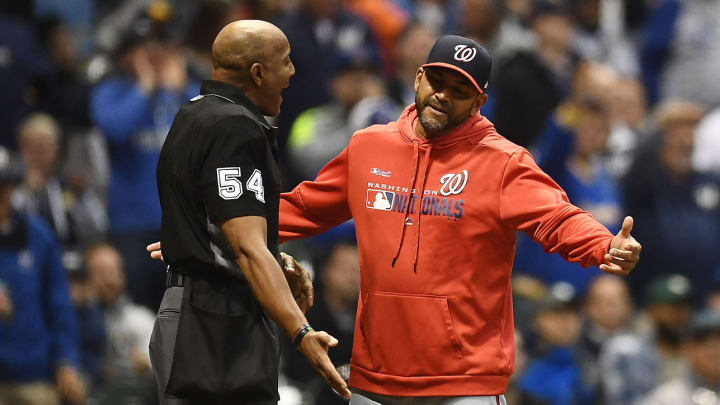Nationals Crisis: Washington Quickly Spirals Toward Disaster in D.C.

The numbers for the Nationals are stark. On Tuesday night, they lost to the Brewers, their third straight defeat and 10th in their last 13. At 14–21, they’re seven games under .500 for the first time since Sept. 18, 2011—their last pre-Bryce Harper season before this one. (Harper, in case you were wondering, hit a grand slam on Tuesday for the Phillies, because the universe is cruel like that.) They trail Philadelphia, which walloped the Cardinals, by six games already in the NL East and are closer to the last-place Marlins than to the top of the division. They’ve allowed the most runs in the NL at 187, or 5.3 per game, and have a negative run differential. They’ve been equally bad at home and on the road (7–11 at the former, 7–10 for the latter), and they won neither consecutive games nor a series since April 17–18.
To put it quickly and bluntly: Things are really bad in the nation’s capital. Washington is trying to get by with a piecemeal roster, a pitiful lineup, a thin rotation, and a bullpen that doubles as an expletive. The injured list sags with talent: Juan Soto and Trea Turner are both out, as are Ryan Zimmerman and Matt Adams, leaving the Nats to play Howie Kendrick at first base (though amazingly, given that he’s somehow got a 157 OPS+ at age 35, he’s the least of their issues). Anthony Rendon is back, at least, after missing time with a bruised elbow, though he promptly went 0-for-3 and was ejected for arguing balls and strikes in his return, because the universe is cruel like that. (Though in his defense, it was a lousy strike call by the perennially awful C.B. Bucknor.)
Rated R for language (we assume). pic.twitter.com/zMfVzPSAre
— Milwaukee Brewers (@Brewers) May 8, 2019
There are holes everywhere you look. Brian Dozier and Wilmer Difo may be the worst middle-infield combo in baseball right now, with respective OPS+ figures of 76 and 65. Victor Robles, a popular NL Rookie of the Year pick, has a .306 on-base percentage and 41 strikeouts in 137 plate appearances. Top prospect Carter Kieboom came up, banged two home runs in his first three games, then went 2-for-his-next-27 before being demoted Tuesday to make room for Rendon. Manager Dave Martinez’s bench features no-names like Andrew Stevenson, Jake Noll and Adrian Sanchez. His bullpen has exactly two reliable arms in Sean Doolittle and Kyle Barraclough.
All that’s working for Washington right now is the rotation, and even that’s not firing on all cylinders. Max Scherzer, Stephen Strasburg and Patrick Corbin are as strong a top three as exists, but they can’t make every start. Anibal Sanchez (5.15 ERA) and Jeremy Hellickson (5.33) have been dreadful and unreliable. And it matters little how good those starters have been or could be when the bullpen is determined to torch leads at all costs.
There’s a feeling, too, like the Nationals don’t know how to fix this. Last week, they canned pitching coach Derek Lilliquist, a move that Martinez bizarrely described thusly: “This wasn’t a decision that was made two or three days ago. There’s something that was thought out for a while.” That makes little sense: If Lilliquist’s job was in jeopardy for that long, why was he still on the staff? It’s also a strange comment given that the season is just a month old, suggesting that Martinez and general manager Mike Rizzo were considering replacing Lilliquist from the get-go.
A coach getting fired is a common move when things aren’t going right, but it speaks to a lack of imagination or options in Washington—or at least, recognition of the old saw that you can’t fire the players. The Nationals’ problems go beyond Lilliquist, as the week since his firing has proven, and a lot of them have to do with a roster that’s talented but brittle, and wasn’t substantially or meaningfully upgraded over the one that finished just a smidge over .500 after coming into 2018 with real World Series hopes. That’s especially true of the bullpen, where Rizzo bargain-shopped and came away with reclamation projects like Trevor Rosenthal (a 36.00 ERA, nine walks, five wild pitches and three hit batters in three innings, and now on the IL as he tries to figure out how to pitch again) or end-of-the-line lefties like Tony Sipp and Dan Jennings. Craig Kimbrel was (and still is) available; so were more reliable options like Zach Britton, Adam Ottavino and David Robertson.
That was the Nationals’ offseason in a nutshell, one that didn’t extend much beyond lavishing $140 million on Corbin (which has, admittedly, worked out). They passed on Harper and let him go to a division rival, offering him only a contract so heavily deferred it would be paying him into the next half of this century, and turned to the talented yet untested Robles, who’s barely holding his own. With a hole at second base, they gambled on Dozier, a declining veteran now moldering in the dirt. They simply ignored Kimbrel, largely because ownership didn’t want to pay a luxury tax penalty.
Now this is the result: a below-.500 team with declining postseason odds (48.3% heading into Tuesday, per FanGraphs, all the way down from 79.1% before the year) and a brutal stretch of games that could very well bury it in the division. Still to come in May: two more against Milwaukee; four versus the Dodgers in Los Angeles; seven against the Mets; and three versus the Cubs. There’s no rest and no escape. This month will make or break the Nationals, and while they can take solace in the fact that no one in the NL East seems to be good (or at least good enough to pull significantly away from the pack), to paraphrase Yogi Berra, it’s getting late early in Washington.
